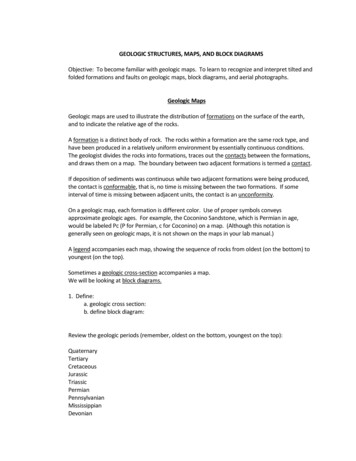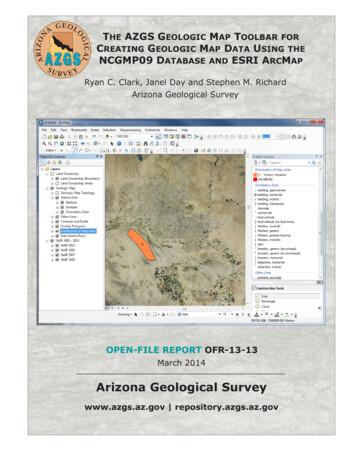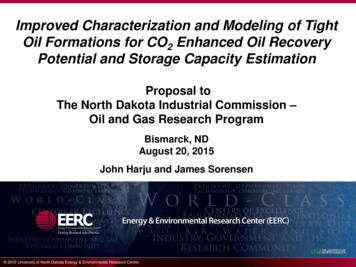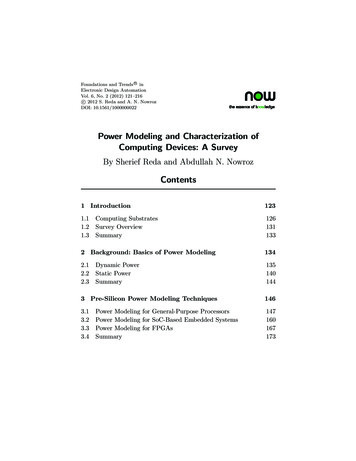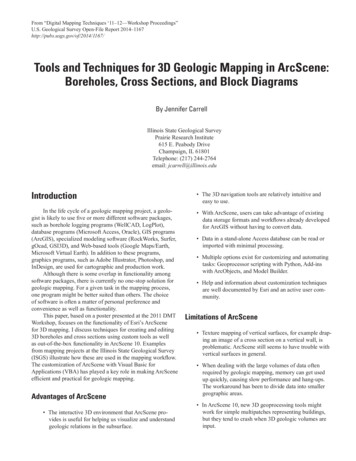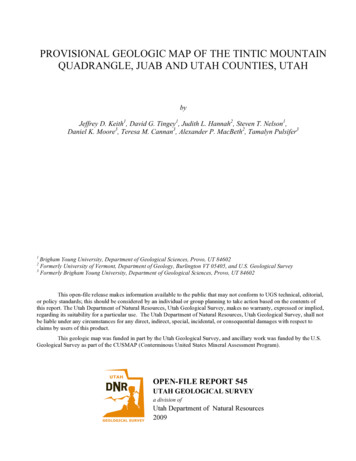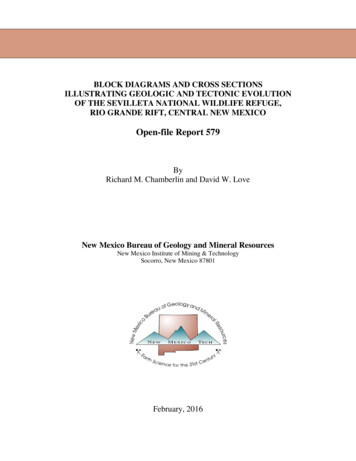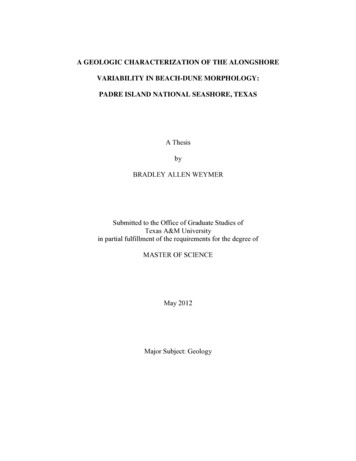
Transcription
A GEOLOGIC CHARACTERIZATION OF THE ALONGSHOREVARIABILITY IN BEACH-DUNE MORPHOLOGY:PADRE ISLAND NATIONAL SEASHORE, TEXASA ThesisbyBRADLEY ALLEN WEYMERSubmitted to the Office of Graduate Studies ofTexas A&M Universityin partial fulfillment of the requirements for the degree ofMASTER OF SCIENCEMay 2012Major Subject: Geology
A Geologic Characterization of the Alongshore Variability in Beach-Dune Morphology: PadreIsland National Seashore, TexasCopyright 2012 Bradley Allen Weymer
A GEOLOGIC CHARACTERIZATION OF THE ALONGSHOREVARIABILITY IN BEACH-DUNE MORPHOLOGY:PADRE ISLAND NATIONAL SEASHORE, TEXASA ThesisbyBRADLEY ALLEN WEYMERSubmitted to the Office of Graduate Studies ofTexas A&M Universityin partial fulfillment of the requirements for the degree ofMASTER OF SCIENCEApproved by:Co-Chairs of Committee, John R. GiardinoChris HouserCommittee Member,Timothy DellapennaHead of Department,John R. GiardinoMay 2012Major Subject: Geology
iiiABSTRACTA Geologic Characterization of the Alongshore Variability in Beach-Dune Morphology:Padre Island National Seashore, Texas. (May 2012)Bradley Allen Weymer, B.S., Millersville UniversityCo-Chairs of Advisory Committee: Dr. John R. GiardinoDr. Chris HouserThe alongshore variability of beach-dune systems and the response and recoveryfrom extreme storms remains poorly understood. The height and extent of foredunesalong barrier islands varies over a range of spatial scales, implying that during extremestorms, the beach-dune system should respond in different ways depending on theelevation and volume of the dunes relative to the storm surge. The purpose of this studyis to use Ground-Penetrating Radar (GPR) and vibra-cores to investigate the internalstructure of small, intermediate and large dunes along a 2.5 km transect of beach inPadre Island National Seashore, TX with particular attention to storm impacts. A seriesof dune normal and parallel GPR profiles were collected to capture the variation inbeach-dune morphology at the three sites. Site locations were chosen along a transitionfrom dissipative to intermediate beach states. Following the Sallenger (2000) stormimpact model, the small dune is defined by low-lying topography that is susceptible tooverwash and inundation depending on the size of the storm surge. The large dune ischaracteristic of the “collision regime”, while the intermediate dune represents atransition between “overwash” and “collision regimes”, with the underlying assumption
ivthat all three dunes would be impacted by the same level of surge during a single stormevent. Results from the GPR survey suggest that each site contains a bright, laterallycontinuous radar reflector that is interpreted with the aid of the sedimentary data as anerosional layer. Different characteristic radar facies and sequence boundaries provideevidence as to how each dune evolved through and after the storm. Results from XRFscans and grain size analysis show a direct comparison between the GPR reflectors at thestorm surface and spikes in calcium counts from XRF scans to distinct changes in grainsize parameters at the same depth. It is argued that the location of each shell layercorresponds to a storm surface generated during a single storm, which means it ispossible to interpret different recovery mechanisms. The presence of the storm layeracross the backbeach and dunes provides evidence for the height and extent of the surgeduring the storm event. The data suggests that the small dune was overtopped by thesurge, experiencing minimal erosion and recovery. The intermediate dune wascompletely eroded by the surge, but showed the greatest recovery of all the dune sites.The large dune was scoured at the base with marginal impact along its crest and showsminimal recovery after the storm. These results suggest that the evolution (i.e.,transgression) of a barrier island varies considerably over short distances.
vDEDICATIONTo my family and friends, thank you for always being there.I dedicate this manuscript to my grandfathers;Horace J. Weymer and James T. Morton.
viACKNOWLEDGEMENTSI would like to thank my co-chairs, Dr. Rick Giardino and Dr. Chris Houser, andcommittee member, Dr. Tim Dellapenna, for their guidance and support throughout thecourse of this research. I especially express my sincere gratitude for my supervisors Dr.Brad Clement, Dr. John V. Firth, Phil Rumford and Bill Wasson at the Integrated OceanDrilling Program (IODP) for providing funding support through the San Andreas FaultObservatory at Depth (SAFOD) research grant. I will forever be indebted to theirunwavering generosity and for giving me the opportunity to pursue my dream ofbecoming a graduate student. I especially thank Dr. Debbie Thomas for her guidance andsupport since beginning my academic journey at Texas A&M. I thank Dr. Robert Weissfor his support during my first year in graduate school. A very special thanks to Dr.Mark Everett and Dr. Doug Sasson for their expertise in GPR data acquisition andprocessing. I thank Dr. Doug Sherman for numerous encouraging conversationsregarding my research. I would like to thank Brian and Daniel Labude, Gemma Barrettand Renee Francese for their hard work and dedication in the field and many stimulatingconversations. I thank Eugene Farrell for his guidance and expertise with the grain sizeanalysis. I thank David Houpt, Thomas Gorgas and YuliaVasilyeva at (IODP) and Dr.Mitch Lyle for their recommendations and expertise in XRF scanning and datainterpretation. Additionally, I would like to thank Antonio Pereira for processing theXRD samples. And lastly, to my parents Rick and Beth Weymer, sisters HilaryThompson and Bethany Weymer and my fiancé Ruifang Xie for their unconditional
viilove, understanding and patience. This study was supported in part by the NationalScience Foundation under award number GSS-0920851 (to Dr. Chris Houser) and by theNational Park Service permit number PAIS-2010-SCI-0020.
viiiTABLE OF CONTENTSPageABSTRACT .iiiDEDICATION .vACKNOWLEDGEMENTS .viTABLE OF CONTENTS .viiiLIST OF FIGURES .xLIST OF TABLES .xiiiINTRODUCTION AND PROBLEM STATEMENT .1PADRE ISLAND NATIONAL SEASHORE STUDY AREA .4LITERATURE REVIEW .9Conceptual Models of Beach-Dune Interaction .The Use of GPR in Coastal Studies .Vibra-Coring in Coastal Environments .Grain Size Measures .Determination of Beach and Dune EnvironmentsFrom Grain Size Analysis .Geochemical Characterization of Coastal Sediments .13162224METHODS.32GPR Data Acquisition .Processing of GPR Data .Vibra-Coring .Core Processing and XRF Analysis .Grain Size Analysis .34374041422629
ixPageGPR RESULTS .43Small Dune GPR Profiles.Intermediate Dune GPR Profiles .Large Dune GPR Profiles.GPR Profile Comparisons .46495155VIBRA-CORE RESULTS .57Small Dune Cores .Intermediate Dune Cores.Large Dune Cores .Comparison of Storm Surfaces between Sites .XRF Calcium Count Comparisons.5963666970DISCUSSION .75Interpretation of the Small Dune GPR Profile .Interpretation of the Intermediate Dune GPR Profile .Interpretation of the Large Dune GPR Profile .Storm Impact Model for Padre Island National Seashore .75777881CONCLUSION .86REFERENCES .88APPENDIX .94VITA . 105
xLIST OF FIGURESFIGUREPage1Location map showing aerial LiDAR image fromDecember, 2010 and satellite image of the three study sites .52Example of coppice dunes along the backbeach stabilizedby seaweed .83Schematic diagram showing variables used in the Sallengermodel of storm impact on barrier islands .124Dune evolution model based on GPR studies from Norfolk, UK .175Radar facies .196Detailed structure of a parabolic dune ridge at Abberffraw,North Wales.217Detailed plots of grain size parameters along Mustang Island, TX .278Scatterplot showing skewness vs. kurtosis distinguishing thethree types of environments. .299Photographs, ground-based LiDAR scans and total station profilesfor all three sites .3610GPR processing steps .3811Modified vibra-coring system accommodating3-inch-diameter PVC pipe .4112Site 1-3 GPR profile comparisons at the samevertical and horizontal scale .4413Configuration of GPR Transects Used at Each Site .4514Small dune location, showing main GPR transect (T2A)and small blowout .47
xiFIGUREPage15Small dune normal GPR profiles; main profile (T2A),south profile (T2B), north profile (T2C) .4816Intermediate dune normal GPR profiles; main profile (T1A)south profile (T1B), north profile (T1C) .5017Large dune normal GPR profiles; main profile (T3A)south profile (T3B), north profile (T3C) .5218Dune parallel profiles for each site .5419Example of XRD peaks for intermediate dunebeach core at 0 cm depth .5820Small dune site vibra-cores and beach profile,showing relative locations .6021Small dune beach core plot showing visible organic layers,normalized Ca counts and grain size parameters .6122Comparison of storm surfaces between the small,intermediate and large dune sites .7023Comparison of Ca counts across the beach, beach-dune interfaceand dunes for each site .7224Comparison of Ca counts for each environment betweenthe three study sites .7425Small dune GPR profile and interpretation .7626Intermediate dune GPR profile and interpretation .7827Large dune GPR profile and interpretation .8028Small dune beach-dune interface core plot showing visibleorganic layers, normalized Ca counts and grain size parameters .9429Small dune top of dune core plot showing visible organiclayers, normalized Ca counts and grain size parameters .95
xiiFIGUREPage30Small dune backdune core plot showing visible organic layers,normalized Ca counts and grain size parameters .9631Intermediate dune site vibra-cores and beach profile,showing relative locations .9732Intermediate dune beach core plot showing visible organiclayers, normalized Ca counts and grain size parameters .9833Intermediate dune beach-dune interface core plot showingvisible organic layers, normalized Ca counts and grain size parameters. .9934Intermediate dune top of dune core plot showing visibleorganic layers, normalized Ca counts and grain size parameters . 10035Large dune site vibra-cores and beach profile,showing relative locations . 10136Large dune beach core plot showing visible organic layers,normalized Ca counts and grain size parameters . 10237Large dune beach-dune interface core plot showing visibleorganic layers, normalized Ca counts and grain size parameters . 10338Large dune backdune core plot showing visible organic layers,normalized Ca counts and grain size parameters . 104
xiiiLIST OF TABLESTABLE1PageGeo-referenced LiDAR elevations from the start and endof the main profile and GPR transect at each site .35
1INTRODUCTION AND PROBLEM STATEMENTThe impact of extreme storms along sandy beaches depends on the height andextent of the foredunes relative to the elevation of the storm surge (Sallenger, 2000). Theimpacts change with increasing storm surge from beach erosion to dune erosion, thus,governing how sediment is transferred across the beach-dune system. The evolution ofbeach-dune systems remains poorly understood. To address this problem,a geologicstudy that used ground-penetrating radar (GPR) and vibra-cores was undertaken tocharacterize beach-dune morphology between small, intermediate and large dunes alongthe northern segment of Padre Island National Seashore, Texas.Numerous GPR studies have investigated beach-dune interaction along a single,two-dimensional cross-shore transect or across beaches in different locations altogether(Bailey and Bristow, 2000; Bristow and Bailey, 2001; Bristow et al., 2000b; Buynevichet al., 2007a; McGourty and Wilson, 2000). However, there is a paucity of data todescribe how beach-dune evolution varies over short distances along the same beach.Typically, dissipative beaches are backed by large dunes, whereas reflective beachesnormally favor small dunes as wave energy is reflected back from a narrower, steepangle, coarse-grained beach and swash-zone (Short and Hesp, 1982). Because offundamental differences between the morphodynamic beach states, the beach-dunesystems between dissipative, intermediate and reflective beaches should be different.Nevertheless, along the same beach it is possible to find transitions between beach statesThis thesis follows the style of Geomorphology.
2that may influence dune development and response of the beach-dune system to extremestorms.This project completed a geologic characterization of the beach-dune interfacefor small, intermediate and large dunes, which may have been impacted by the samestorm in different ways. Variations between the interpreted internal structures of thedunes can be used to characterize the degree of impact from storms. In other words, byidentifying erosional surfaces (i.e., storm surfaces) within the dunes in the context ofinundation, overwash and collision regimes, this project describes how the beach anddune systems interact and what is important regarding these interactions to islandtransgression. The purpose of this project is to conduct a geologic study that usesground-penetrating radar (GPR) and vibra-cores to:1. Characterize alongshore variation in beach-dune morphology for different-sizeddunes.2.Interpret internal structures within the beach-dune system with attention to atransgressing barrier islands response and recovery from storms.To achieve the objectives of the study, dune-normal and dune-parallel GPRtransects were surveyed to create a three-dimensional internal view of large,intermediate and small dunes assuming this can be used to determine whether there aredifferent transgression histories of the beach-dune system within a 2.5 km stretch ofPadre Island National Seashore. Additionally, twelve vibra-cores collected along themain GPR transects (four at each site) provided internal views for the upper meter of theGPR profiles that could not be interpreted because of interference between the 200 MHzantennae. From the vibra-cores, core descriptions, grain size analysis and (X-Ray
3Fluorescence) XRF data were collected to categorize textural properties of the sedimentand identify storm layers within the cores. Thus, the vibra-cores provided supportingevidence of the interpreted storm surface identified in the GPR profiles. The results fromGPR surveys, grain size analysis and XRF data confirm that a distinct storm surfacepersists at a depth of 120 cm along the backbeach at each study site. The difference indune height between each site means that the beach-dune system was impacted by thesame storm in different ways within a relatively small area.
4PADRE ISLAND NATIONAL SEASHORE STUDY AREAPadre Island, a Holocene barrier island, is thought to have formed 5,000 BP(Fisk,1959). The island extends from the southern edge of Mustang Island in the north to theMansfield Channel, which separates North Padre Island from South Padre Island (Figure1). It is the longest barrier island in the United States at 182 km in length. Padre Island isseparated from the mainland by Laguna Madre, a hypersaline lagoon. North Padre Islandis micro-tidal with a mean diurnal tidal range of approximately 0.43 m (Weise, 1980).The northern segment of Padre Island is comprised of a double-barred beach profile,resulting in a predominately dissipative beach state as a function of wide, low-anglebeach and surf-zone geometry. The beach is comprised of fine-grained sands andinfluenced by prevailing southeasterly winds, with a mean speed of 10-12 knots. Thestudy site is located within the protected portion of the beach between the South Beachaccess road (Park Road 22) extending 2.5 km north in close proximity to the MalaquiteBeach campsite (Figure 1). This portion of the beach is part of the restricted area wherethe National Park Service does not allow public vehicles to drive along the beachbetween the entrance to South Beach (Park Rd. 22) and the North Beach access road.Three sites within a 2.5 km stretch of the study area were chosen for the GPR survey.Site 1 represents an intermediate-sized dune that is defined as having a height between2-3.5 m. The smallest dune (less than 2 m) is located at Site 2 and the largest dune at Site3 (greater than 3.5 m) represents the other end member.
5Figure 1. Location map showing aerial LiDAR image from December, 2010(Courtesy National Park Service) and satellite image of the three study sites (Modifiedfrom Google Earth 2011, GeoMapApp 2011).The climate along the coastal region of southern Texas ranges from semi-arid totemperate with an average annual temperature of 22.2 C (72 F) and an average annualrainfall of 74 cm (29.13 in). Hurricanes and tropical cyclones impact the Texas coast atan average rate of 0.67 storms per year, or two storms every three years (Weise, 1980).
6During the last fifty years, Padre Island was struck by Hurricane Beulah (1967),Hurricane Allen (1980), Hurricane Bret (1999) and Hurricane Dolly (2008).The primary sediment source for north Padre Island originates from theMississippi River. Longshore currents along the island are from south to north.Distribution of heavy minerals and bimodal grain size modes identified by Hayes (1964)suggest that along the middle section of Padre Island there is a convergence zone ofmixed sediments from the Rio Grande and northern fluvial inputs (Hayes, 1964;McBride et al., 1996). Textural characteristics of Padre Island beach sand indicate thesand is predominately well-sorted, with a mean grain size of 2.3-2.7 ϕ (Dickinson,1971). Petrographic analysis of sand grains by Mason and Folk (1958) along MustangIsland (approximately 30 km to the north) revealed the mineralogical composition of thesand to be 9% feldspar (about half orthoclase, half microcline), 2% chert, 3% compositemetamorphic quartz and 86 % common quartz (Mason, 1958).It is common, especially during the summer months for large amounts ofSargassum seaweed to wash up onshore, which is described by Weise (1980) to aide inthe development of coppice dune fields along the foreshore (Figure 2a). From summer2010, through summer 2011, the beach has experienced a significant accumulation ofSargassum that usually drifts from the Sargasso Sea via southeasterly surface oceancurrents (Weise, 1980). Several types of vegetation along the backshore and foreduneshelp to stabilize the dunes by trapping wind-blown sand and allowing the dunes to growover time (Figure 2b). Marshhay cordgrass (Spartine patens), morning-glory (Ipomoeaspp.), and sea purslane are common on the lower parts of the dune. The middle and
7upper parts of the dune are stabilized by sea oats (Uniolapaniculata), bitter panicum(Panicumamarum), and gulf croton (Croton puncatus). The thick vegetation cover on theback-side of the foredune primarily consists of seacoast bluestem(Andropogonscopariuslittoralis) (Weise, 1980).
8Figure 2. Example of coppice dunes along the backbeach stabilized by seaweed. (2a),and vegetated foredunes, view looking south towards South Beach (2b).
9LITERATURE REVIEWBarrier islands and spits are found along many of the coastlines of the world.These islands are important from an economic and cultural standpoint as a naturaldefense against coastal storms and hurricanes. Most barrier islands and spits arecurrently in the state of transgression (landward retreat) in response to combinations ofglobal eustatic and local sea level change (subsidence and tectonics) and, as such, aredynamic landforms (Houser, 2009). Barrier islands typically transgress during extremestorms. When the foredunes are breached by storm surge, sediment is redistributed fromthe intertidal zone to the back of the dunes as washover fans and channels and/orblowout development or scarping (Davidson-Arnott, 2005; Houser, 2009; Houser et al.,2008; Sallenger, 2000). During transgression, the barrier island system will migratelandward in response to rising sea-level. The redistribution of sediment during stormsand hurricanes and the rate of transgression depends on the height and alongshore extentof costal dunes relative to the elevation of storm surge(Houser et al., 2008; Morton andSallenger, 2003; Sallenger, 2000). As a consequence, alongshore variations in the heightof the dune and morphology of the beach can lead to different transgression histories andmay be used to predict response and recovery of the barrier island to future storm events.In other words, over short distances along the same beach, alongshore variability of theforedunes will influence transport potential and sediment supply controlling dune growthover time.
10Various conceptual models have been proposed to explain the effects of sea levelrise along the coastlines of the world. Perhaps, the first and most recognizable modelwas proposed by Bruun in 1954 relating shoreline retreat to rising sea-level. Schwartz(1968) suggested shoreline retreat can be predicted since a typical concave-up beachprofile erodes sand from the beach face and deposits it offshore to maintain a constantwater depth. In other words, the redistribution of sediment resulting from rising sea levelsuggests that the landward displacement of the shoreline is a function of the profile slopeand vertical sea level rise, assuming an ample sediment supply landward of the shoreline(Bruun, 1988; Davidson-Arnott, 2005). It has been argued that this two-dimensionalmodel is not sufficient in explaining coastal response to a rise in sea level, because itdoes not take into account the influence of the foredune system (Cooper and Pilkey,2004; Davidson-Arnott, 2005).Davidson-Arnott (2005) proposed a different conceptual model based on theunderlying assumptions stated by Bruun, but include the foredune system, which was notconsidered extensively. The two main differences between the Bruun model and themodel proposed by Davidson-Arnott (2005) are 1) within the subaqueous area during sealevel rise, the outer nearshore profile is eroded and results in a net landward sedimenttransfer to maintain the equilibrium profile and 2) transgression and erosion of thebackshore and dune leads to a net landward transfer of sediment and landward migrationof the dune. It is argued that the majority of sediment transfer occurs during stormactivity. For example, Sallenger (2000) compared large and small dunes at Duck, NC,and Isles Denieres, LA, respectively, to illustrate the importance of dune height as a
11barrier to storm surge. It is reasonable to expect that during a storm event, small duneswould be inundated by the surge resulting in overwash deposits, in contrast to largedunes that may not be breached at all and only scarped by the surge.By comparing the magnitude of the storm surge compared to coastal beach-dunedimensions, Sallenger (2000) developed a useful storm impact scale that accounts forstorm-induced patterns and magnitudes of net erosion and accretion along barrierislands. The parameters used for scaling the impacts of the storm are RHIGH, RLOW, DHIGHand DLOW, where R represents the high and low elevations of the landward margin ofswash relative to a fixed vertical datum and DHIGH/DLOW represent the dune crest anddune base, respectively. From these parameters, a series of storm impact regimes can bedefined by considering how RHIGH and RLOW vary relative to DHIGH and DLOW. TheSallenger (2000) impact model not only considers meteorological conditions of a givenstorm, but also categorizes the geologic impacts between low-lying and high-reliefcoastal dunes as either washover or dune-scarping, respectively.In the four impact levels (Figure 3), Level 1 “swash regime” describes a stormwhere the run-up is confined to the foreshore and there is no net change in sedimenttransport. In the Level 2 “collision regime”, the storm run-up scours the base of theforedune ridge and results in net erosion of the dune. The Level 3 “overwash regime”designates situations where the storm surge overtops the foredune ridge as a washoverand results in a net landward sediment transport responsible for island transgression.With the Level 4 “inundation regime,” the storm surge completely submerges the beach-
12dune system and suggests that landward transport of sediment is much greater thanduring the “overwash regime.”Figure 3. Schematic diagram showing variables used in the Sallenger model of stormimpact on barrier islands. (a) delineation of the 4 different impact regimes along barrierislands during storm events (b) (modified after Sallenger, 2000).Despite the usefulness of the Sallenger (2000) storm impact scale, there is a lackof information in the literature regarding how different dune heights along the samebeach influence the redistribution of sediment during storms. The ability of coastal dunes
13to recover and the morphological response to the next storm depends on the availabilit
of dune normal and parallel GPR profiles were collected to capture the variation in beach-dune morphology at the three sites. Site locations were chosen along a transition from dissipative to intermediate beach states. Following the Sallenger (2000) storm impact model, the small dune is defined by low-lying topography that is susceptible to

